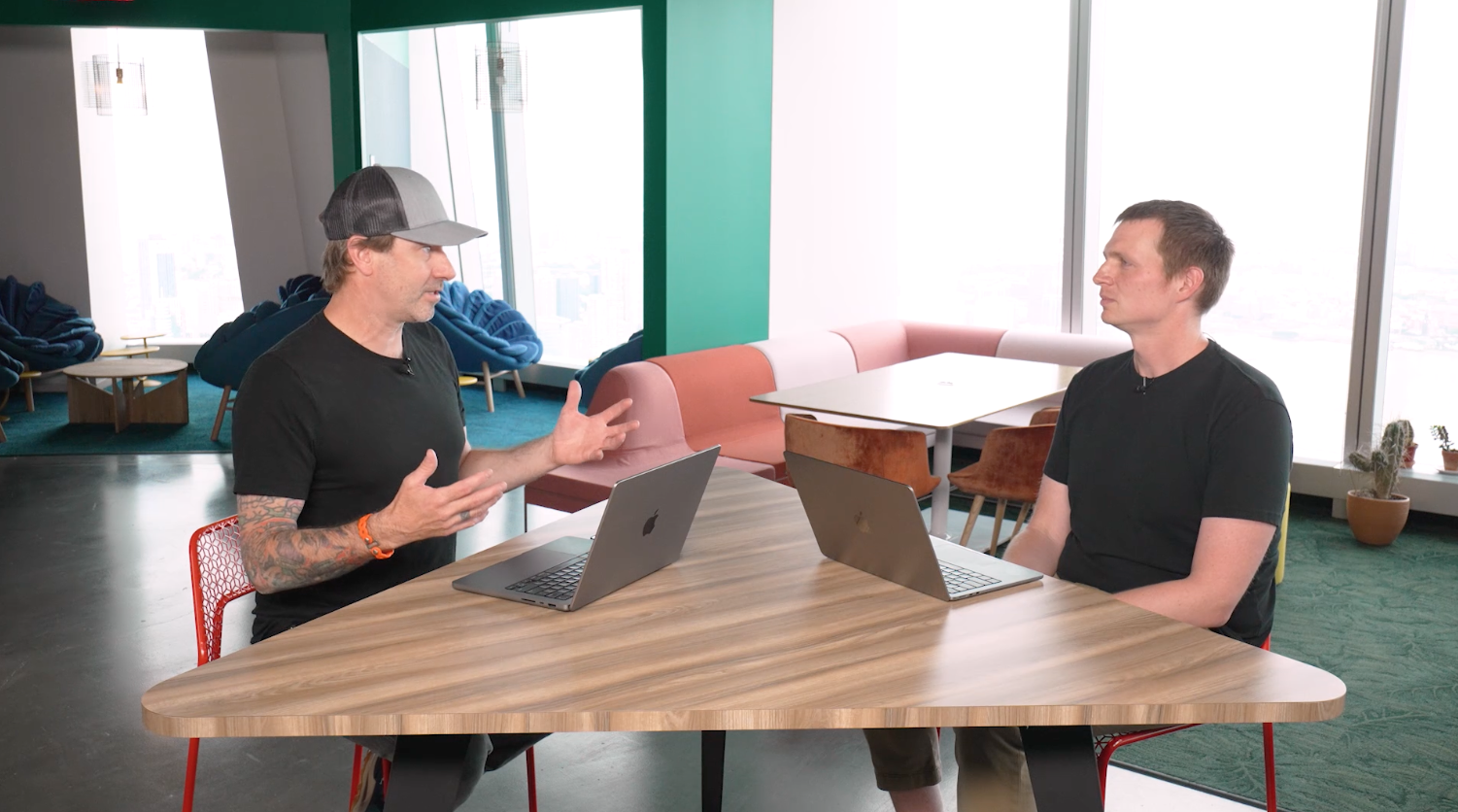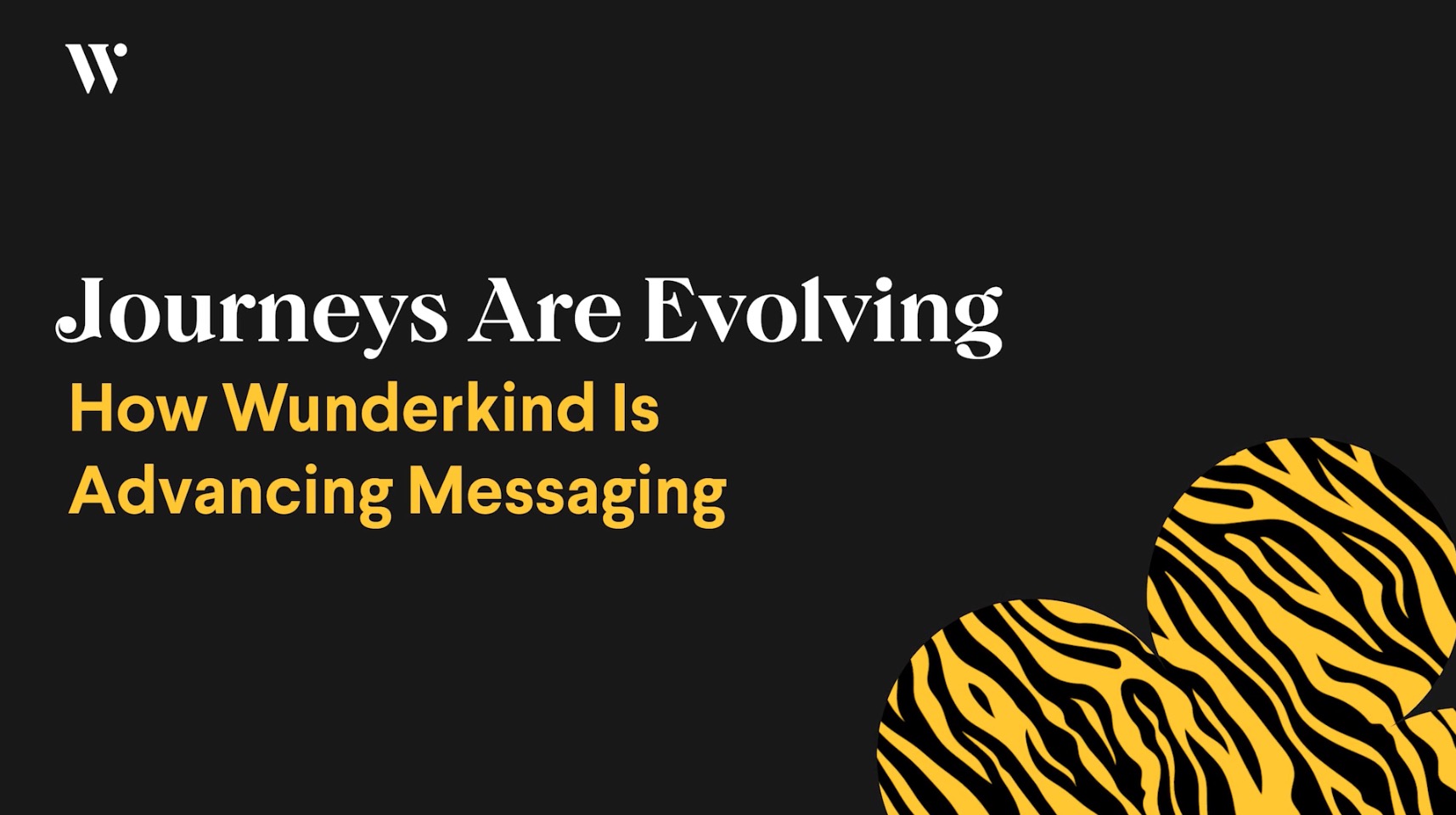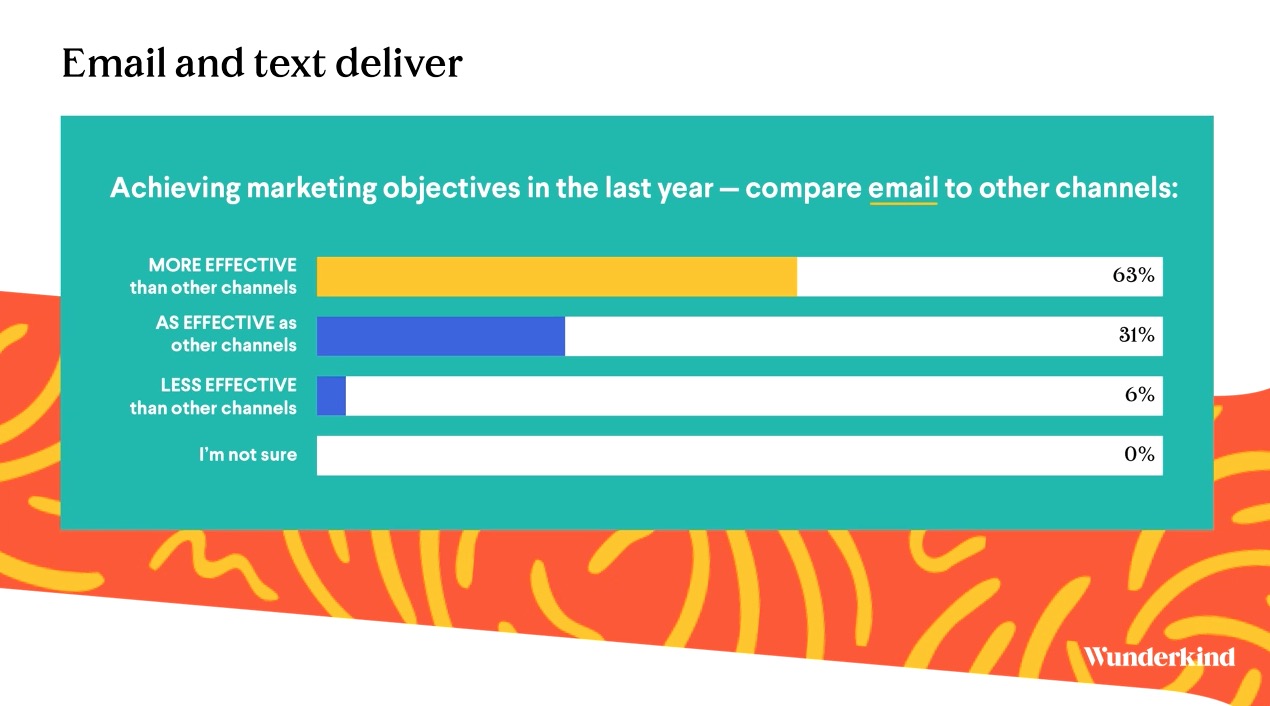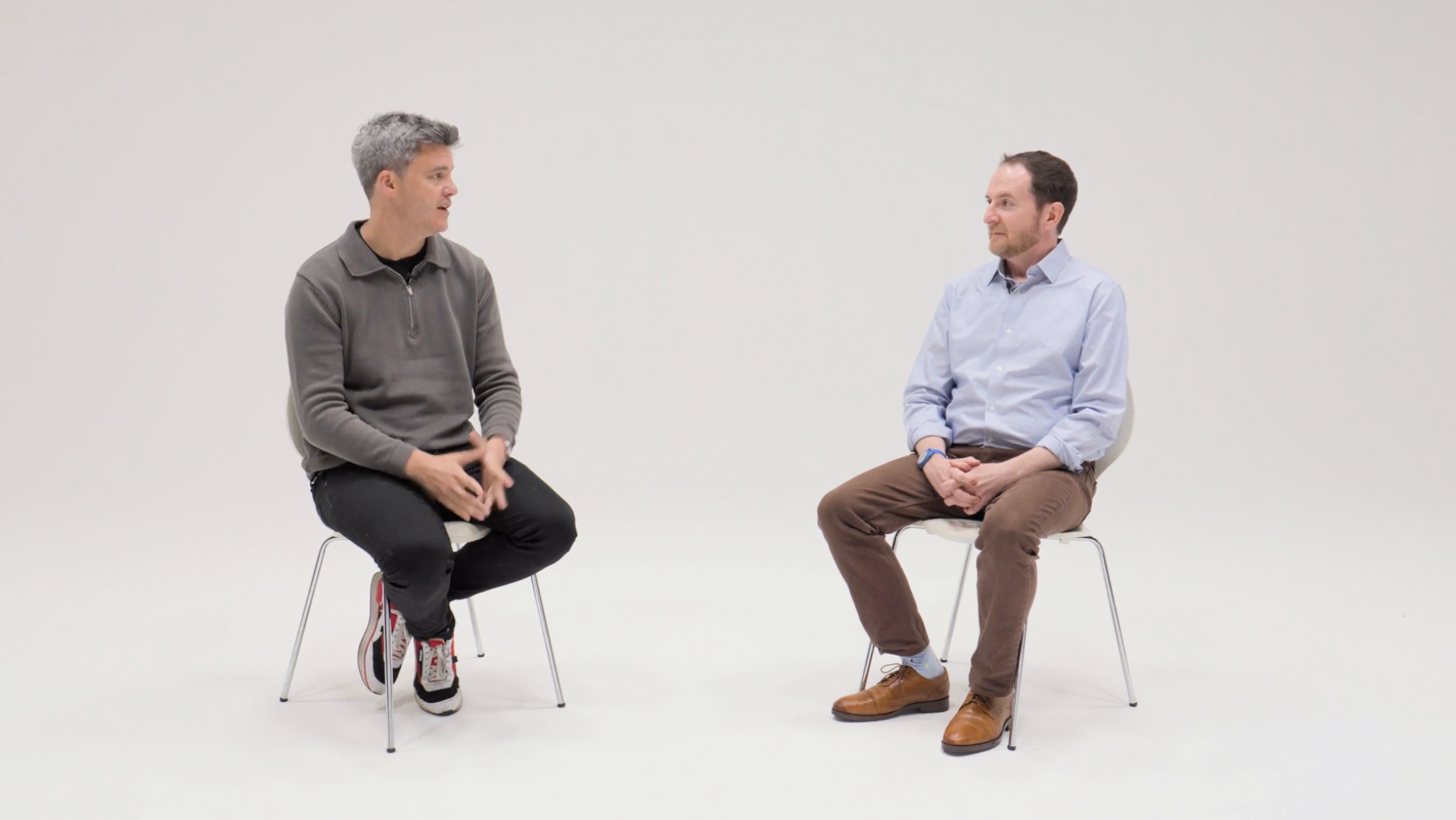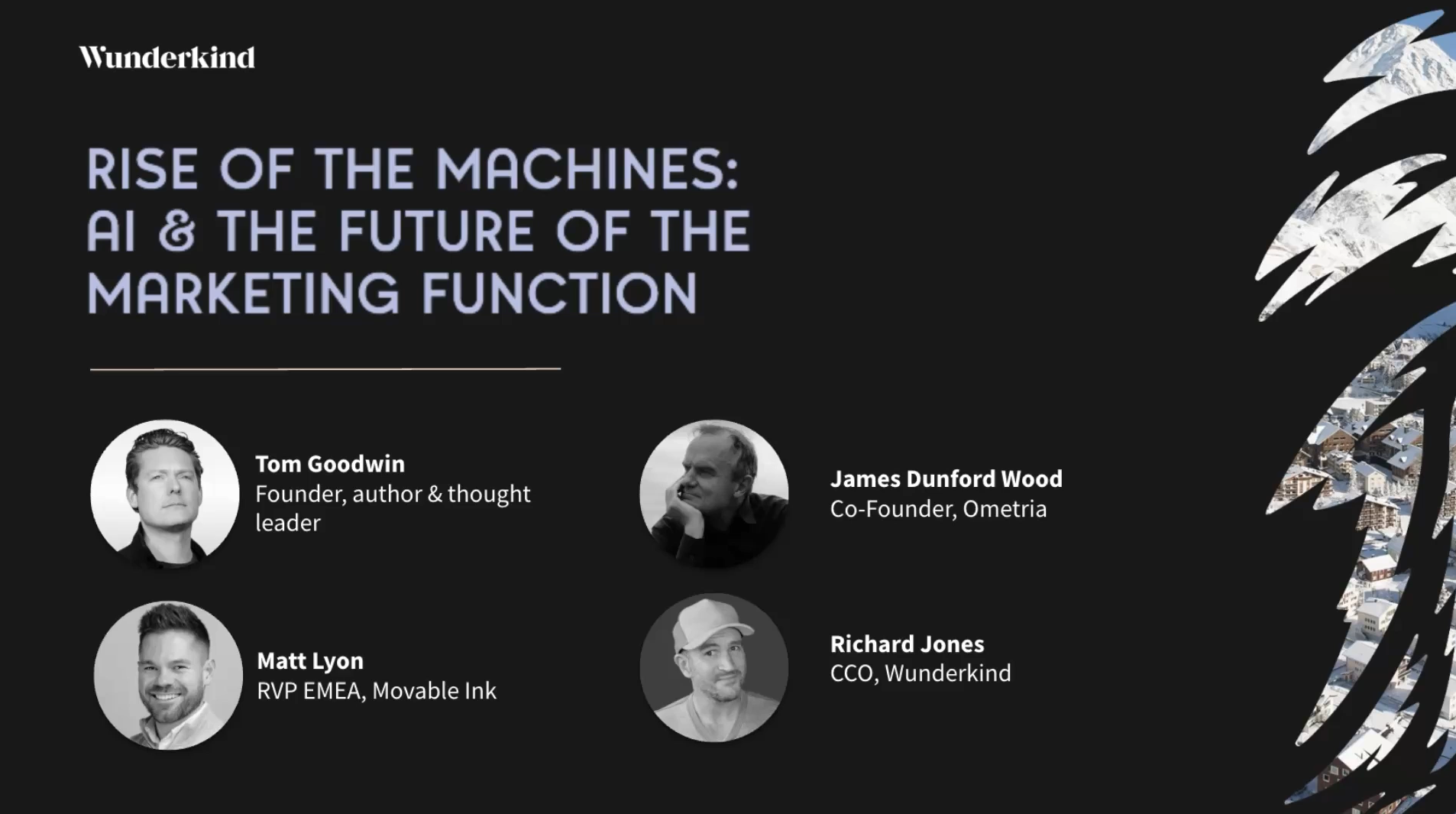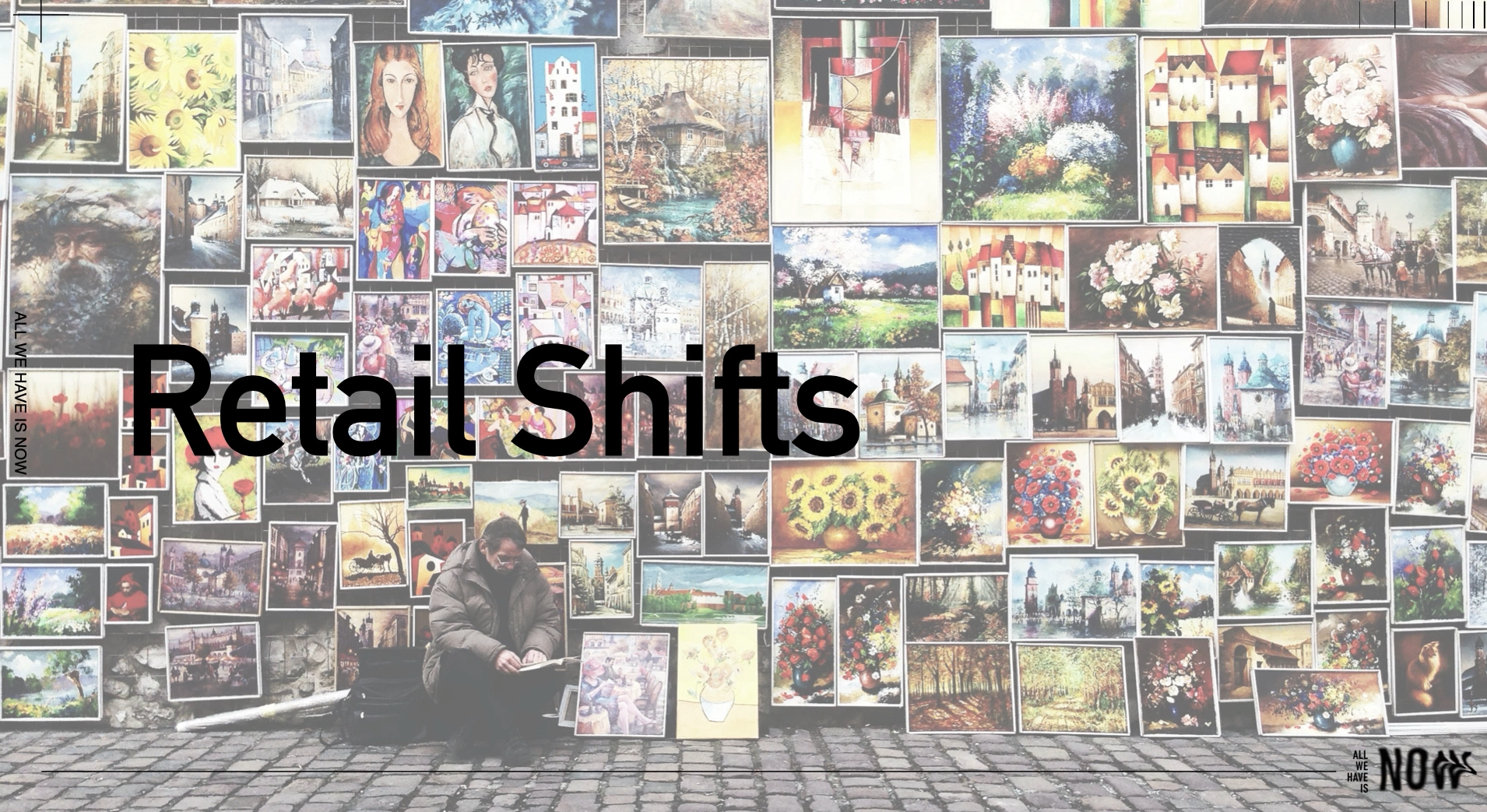How AI & Identity Will Supercharge BFCM Revenue In 2024
- 0.5
- 1
- 1.25
- 1.5
- 1.75
- 2
Tim Glomb: Welcome everybody to this webinar titled How AI and Identity Can Supercharge BFCM Revenue in 2024. I'm Tim Glomb, your co- host today. I am the VP of content, digital, and AI here at Wunderkind, and I am joined by David Freund. Freund, how are you, man? Give us your title so everyone knows what you do here.
David Freund: Doing well. I am the AVP of product strategy and performance here at Wunderkind, and really my job is to make sure that we maximize outcomes for all of our clients.
Tim Glomb: You are a very difficult guy to get pinned down. You're super busy because you do touch our almost a thousand plus clients, like giving them their strategy. So I appreciate you sitting down doing this and you're also one of our BFCM experts. You really know what's going on behind the scenes, what's happening with identity or data, et cetera. So excited to have you. We're going to talk about a bunch of things here, all related into BFCM. Now we're recording in June. It's nice and warm out here, but that holiday season is just five months away from where we sit today. Whenever you're watching, BFCM isn't always on event. You should always be on. We're going to talk about that and the data, the identity, some of the things that you should have for your brands. But David, I was hoping we could kind of kick it off with the definition of identity resolution because it's been thrown around a lot lately. Some would say, " Oh, I have an identity resolution of strategy or tool set. I've got a CDP, and I maybe use LiveRamp or some other ID provider," but it goes far beyond that, right. There's a lot of context underneath identity. Can you give us maybe a definition of identity resolution in your layman's terms?
David Freund: Yeah, so when we think about identity, really we're thinking about what's the proportion of site sessions that we can tie to a first- party identifier, like an email address, like a phone number, and that allows you to send for... that allows you to send own channel marketing, which is really one of the most valuable things you can do with that ID.
Tim Glomb: Yep. But again, there's the context there, right. So one thing is, okay, we can see this device. I'm going to hold up my device. This is Tim Glomb. Maybe we don't know that. He comes to my website. I don't know who he is. He's unknown. An identity resolution might be able to say, " Okay, this device equals timglomb @ gmail or timglomb1 @ gmail," et cetera. But it's the rich context that the Wunderkind Identity Network, in particular, are graph of 9 billion devices, a billion opted in consumers, nearly 2 trillion digital events observed for year. We have a history on that device. Not only can we match it to an identifier. Can you talk a little bit about what some of the context behind a device in a consumer profile might have?
David Freund: Yeah, so it's not enough to know who someone is. You need to know how to market to them best, right. You need to know, know what they're interested in, what they're doing. We have so many events and so much data to help create these robust profiles on folks. We can see which websites they're going to. We can see what they're looking at. What they're adding to cart. When they're adding to cart. Maybe they're gifting at certain points versus buying for themselves. We can create these robust understandings of folks, and that allows us to think about what's the next best opportunity for that person. If we're trying to get an opt- in, what's the best offer or value proposition to exchange... in exchange for that opt- in for email address, for text for both? Or if it's on the triggered side and we've identifying someone who's abandoning the website, what's the best way to get them back? What's the most compelling thing? What's the best way to get margins for your business and getting this... getting them back too?
Tim Glomb: Got it. And look, a lot of ESPs, and I think we're going to talk about this a little further down the agenda, but ESPs will tell you, " Hey, we can do abandonment cart and we can get them back." But they can't always recognize all of the opportunities, like you just mentioned, kind of a category abandonment. Tim's looking at shoes, didn't put anything in his cart, and left." That's a signal. That's a trigger where Wunderkind can say, " Great, this is the kind of email or this is the right email to send to for Tim, he has multiple, and here's the creative we suggest." You might even be able to... You don't tell the brand this, but Wunderkind knows, " Well, Tim is... has a higher average basket value typically when he buys, so maybe he doesn't need a deep discount to get him back. He just needs a reminder that the product is there or maybe a mention of loyalty rewards if he were to buy, et cetera." That's the kind of context we can bring.
David Freund: 100%. Or maybe we know that Tim's already bought before, so maybe we shouldn't be asking for his email address at all. How many times have you been to a brand, you're already on the email list, and the first thing you see is a popup asking you to sign up for email? Maybe you're signed up for email but not for text. So, really, the opportunity is how do we get this person on the loyalty list? How do we get this person on the text list? So it's really thinking about the UX of the user as well as what the best actual value prop is.
Tim Glomb: That's a good one. Let's talk about this because one of our bullet points here is how do acquire more first- party data to be used for BFCM. So acquiring that all year round, but really activate it in a BFCM. And as we know, cookies are going away, right. A lot of marketers and brands watching right now are... have giant budgets or decent budgets for remarketing via ads. That is going to be disrupted tremendously with Google in 2025. So they need to be acquiring more of the first- party data. How can we use context like the Wunderkind Identity Network? How can we use the context we have on a given device to even inform that popup, right? Can we have a different offer because the brand doesn't know who that device is? It might be the first time they came, or it's been unknown, and now they want to convert it. Talk to me a little bit about how our context is helping shape even those acquisition value exchange offers.
David Freund: Yeah. So if we know that you come to the site a ton of times recently and you're really interested in a specific item, that might be someone very different than someone who's maybe come once or twice and bounced immediately, right. There are some people who we know are probably going to need an incentive to drive that opt- in. There are some folks who really might just want to know that they're going to get their item faster, and maybe offering free faster shipping is going to be the value prop there. And again, there are some people where you might not need an offer at all, and you can just think about what's the value that you get by joining the email list or joining the loyalty program. So understanding what people are looking for, how often they're coming to site, what their intent is, is really, really important. And it should... we should be offering people different value propositions in exchange for an opt- in, right. You shouldn't be offering everyone the same thing because not everyone's the same.
Tim Glomb: Yeah, it makes total sense. And what I think about this, if I put my brand marketing hat back on, right. I've been in tech for almost 10 years, but before that brand marketer always trying to gain more information. Wunderkind is almost that partner who knows who's coming to my website. Let's call my website a party, right. That's the party. We have an unknown guest who just walked in and the host, I'll call it ACME Brands, right. The brand's like, " We don't know who this device is. What do they want? We want to get them in our email list." Wunderkind brings that context and is like, " Oh, we know what will get them hooked in and get going." So ESPs have great popup opt- in tools, right, but they're generic. They're usually a one size fits all. Like, " Hey, let's give everyone 20% off and get their email or mobile number." This is like personalization from first touch.
David Freund: Yeah. Ultimately, it is nothing revolutionary to show a popup to ask for an email address, right. It's been going on in the market-
Tim Glomb: inaudible.
David Freund: ...for quite a long time, not that difficult. What is difficult is to make sure that you have a strong user experience and you're providing the right value proposition to get the most users opted in. Also, at the best margin for your business. So is an ESP going to know that someone is more likely to convert versus less likely to convert when they first arrive on the website that they've been to the website and looked at certain categories across multiple devices? Probably not. So, an ESP, you're really going to be thinking about, " What's the best offer I can afford to give to everyone?" Whereas with a solution like Wunderkind, really what we want to be doing is thinking about what's the best offer for this individual person based on your goals as a business, right? Maybe you want to ramp up the offers for certain folks because it's really going to be more compelling. So you're actually willing to go above your average offer to try and pick up those extra people who really need it. But for the folks who are higher value, when we're thinking about the next purchase already, maybe it's really more about just making sure that we offer the lowest value proposition possible that gets them in the door.
Tim Glomb: Yeah, that's good. And it's worth noting you think through this. If somebody comes to your site, they're unknown. They're an unknown device, that means you don't have their email address, most likely. So your ESP has zero insight into them, right?
David Freund: Correct.
Tim Glomb: They have to be inside the email provider to even be recognized, and they would've had to have taken a recent action. Maybe clicked an email, opened an email, or clicked on an offer to get that cookie to fire to remember to get them back. So this is why you're going to need an identity resolution partner, much like Wunderkind, where we understand that device, we understand the consumer behind it, and we can get you the optimal offer to even just get them in and acquired.
David Freund: And I'd also note this is works at a channel level too. You'd look, at most ESPs, if we're trying to get someone on email and text, you're usually going to see either one step or two steps in a popup to try and get you to sign up to everything. And if you're not signed up to one of those, you're still going to get asked to sign up to both again, even if you're signed up to one channel. You want a provider who knows which channels the user has already opted into so that we're not going to bother people who are opted into email by asking them for email again before we ask them inaudible the text list.
Tim Glomb: Yep.
David Freund: Let's make sure that we provide the right value proposition to get them the right next place for your business.
Tim Glomb: Yep.
David Freund: We're not going to give them an offer for a first- time customer discount that they probably can't even use a checkout. That's just going to upset them.
Tim Glomb: Yep, that's a good call. So seamless customer experience. When you have that rich contextualized identity information from a partner like us. And it's worth noting identity partners, there's a million identity partners out there, right. They can say, " All right, this device equals this email." Well, again, I start to see that in my own because I have, I think, seven emails on my devices. We're talking laptops, iPads, phones, et cetera, multiple devices per consumer, and usually they miss. Timglomb @ gmail is the one that I really like. So sometimes I'll see offers when I go open those old business accounts, I'll open them once every couple of weeks, and I'll see things stacked in there, I'm like, " You were using the wrong one." If you had a partner who understood my primary email, the one that I transact with most do the most buying with, again, you're going to get the right one.
David Freund: Yeah, you got to know which email people buy with, but also which email people are looking at at different times, right. Maybe there's certain times of the week or certain times of day where you really are paying attention to that business email, or for certain brands, it makes more sense because it's tied to what you're working on. So all that context matters, and it's really important to factor in which devices and which email addresses or which phone number are people using at given times.
Tim Glomb: Fair. Well, look, I want to play a clip from one of our clients. Kurt Geiger is a great global fashion brand and a really, really intelligent chief digital officer over there, Gareth. I want to roll this clip right now of how they use us to double their acquisition rates on their website. They were kind of blown away. It was kind of like a gift, an unknown. They really wanted our identity and contextualized for triggered messaging, and then their acquisition strategy just exploded. And here's Gareth explaining why that acquisition feeds the full funnel of their remarketing and ad budgets. Check this out.
Audio: I mean, what surprised me about Wunderkind is how fast they beat their ROI model. So very rapidly, it was evident that the abandoned browser, abandoned basket campaigns were delivering far in excess of the revenues that we had previously and much better than the base case solution for the ROI model. So that straight was a tick. So we put it onto our America site, and we saw those abandoned browser, abandoned basket revenues from our automated campaigns within CRM through our own CRM tools double and just keep increasing in number all the time. I guess the surprise to me and the bit that wasn't really sold as well, but one of the reasons why I signed the contract was on that email capture rate. So we were capturing 5, 000 emails a week in the US. We put the Wunderkind technology in, we captured 10, 000 a week right out the doors, and that has never slowed. So it doubled our email capture rate. So that first- party data capture piece then fed into abandoned browser, abandoned basket was a real two- way win for me. And then what happened very quickly after that is we got ourselves together with this new data. We've got all this first- party data. We've got better journeys for our consumers. Can we use... utilize this data in other places? So then we started to use that data in our paid media campaigns to fuel that whole efficiency. So we weren't having to use paid media to target these people. And then they were coming to the site, then we were getting their email address. So what it allowed me to do in an emerging market was be more confident in pushing my marketing up the funnel. Previously, I might be just on like, " All right, CPM. We think it's okay, but is it really revenue driving?" But what we were using in the mid- funnel was the email capture rate as a KPI for mid- funnel, which allowed me to keep feeding the top of the funnel and build efficiency into my marketing. That was just one part actually that we realized in the efficiency and marketing that the tool gave us that wasn't part of the sales pitch. So if I was just looking at straight off, did it deliver on ROI on abandoned browser, abandoned basket? It did that. But actually, there was a couple of extras that I almost got for free. So it was great.
Tim Glomb: Great. Really, really intelligent one. There's a full case study there. We're going to show you a QR code on how to watch that full case study at the end of this video. But let's move on. Dave, let's get into BFCM here, right. People want to know how does all this work into BFCM. Can you tell me a little bit about when will consumers start engaging in the holiday season? It feels like it gets earlier and earlier every year, but you guys get a hard look at data and trends. So what do you see when it comes to consumers leaning forward with brands around BFCM holiday season?
David Freund: Yeah, it definitely happens earlier every year. At this point, usually after Halloween you can assume that your customers are waiting for a Black Friday, Cyber Monday offer.
Tim Glomb: inaudible.
David Freund: It depends on the brand, right. Bigger ticket items people tend to wait longer for and save for because it's a bigger... higher consideration purchase with smaller, lower consideration purchases. Sometimes, you see that a little bit later for the brand, but everybody's prime for Black Friday at this point. I think the industry and everyone we've all been taught to wait for the best deals. So that's when people need to start at least being told when you're going to have offers.
Tim Glomb: Got it. So that's when brands really need to start saying like, " Hey, look, holiday's coming. If you're not in our list, here's an acquisition popup. You got to have that in place. That's got to be happening." And are brands starting to... are they on board here? Are they sending more email campaigns and text campaigns around Halloween to get that kicked off?
David Freund: Some are, and they're seeing a lot of success. Where they're seeing a lot of success is what you mentioned earlier with permissioning and getting folks opted in, right. There's a lot of folks who are exploring sites and doing some discovery even way before holiday to think about what they're going to buy over Black Friday, and this is the best time to get someone to opt in. Most of the year, I think we all know that one of the most compelling reasons people will opt into an email list is to get a discount. We don't all love it, but it often works for various brands. This is the one sort of time of year when it doesn't... that's not always the case. The discount today, people don't expect to be better than your discount, say two weeks, three weeks, four weeks at this point in the year in November. So sometimes, for brands, it's actually far more compelling to tell people, " You can be the first to get access to our sale, or you're going to... we're going to make sure that you don't miss it" because folks really want to know when the best offer is coming. This is something that's worth testing for your brand because not every brand's the same, but it's one of those counterintuitive times a year when really you should be changing your value propositions and thinking about how to maximize your list growth.
Tim Glomb: Got it. So maybe use a little bit of that FOMO, like, " Hey, holidays are coming. Don't miss our sales." And I've seen a lot of brands do, " Hey, for the next eight weeks or whatever, we're going to have a deal per week," or something like that. These are the kinds of trends and carrots that brands are dropping to kind of get people acquired and start opening emails.
David Freund: 100%. You may have a large email list to be thinking about growing your text list. This is the perfect time to utilize those high- intent folks on your email list. Tell them that text users are going to get an hour early access first and get them to join the text list. This is the best way if you want to get folks on a second channel, easiest opportunity is to use email right during that two to four- week lead time before the holidays.
Tim Glomb: Got it. All right, interesting. And now you're talking about two identifiers, two different channels. But again, try and get that all in one seamless profile, right.
David Freund: Yeah.
Tim Glomb: I mean, that's again, another part of the Wunderkind advantage here is you can have email and SMS in one. You don't have to have two different vendors. You're stepping all over each other for campaigns. " Oh, did we send him an email? Oh, no. Did we send him a text? Which one does he want?" So two- channel strategy is huge. Are you seeing clients start to adopt more of a two- channel strategy and trying to mucks both of those into one consumer profile in their stack?
David Freund: We definitely are seeing attempts. I think it's really tough to do it well, and this is where AI and ML come into play. There are unique advantages to each channel, and what we see across the board for a lot of businesses right now is that folks are kind of treating texts the same as email, right. They're sending a text every time they send an email. They send it to every single person on the list. One, that's expensive, but two, text has unique advantages over email, right. You're probably not going to ignore a text message. If you have an unread message, you're probably at least going to click on it and look at it. So that's like 100% viewability, similar to what you might think of an ad. Whereas email is something that people come back to later all the time, and it's less of an interruption. So you want to think about how those two can interact. You can prime people to expect an email the next day by making sure everyone sees a text message, telling them it's coming. And there are all kinds of other ways that you can kind of combine those strategies and tactics.
Tim Glomb: Gosh, I could go down that rabbit hole with you for two hours. Maybe we should do another webinar on that alone, but we got to move on here. I want to talk a little bit about some of the incentives that you saw brands offering and some of the tactics that were driving sales in 2023. I know you had a lot of historical data. We talked a little bit about this in our post- 2023 holiday webinar, but what have you seen? What types of offers and what tactics are working?
David Freund: Oh man, we've got a lot of stuff here.
Tim Glomb: Okay. Well, let's do bullet points-
David Freund: Yeah.
Tim Glomb: ...because, again, at the end, we're going to show them our recap from 2023. They can go watch another webinar, but skim over the top and bullet points for me.
David Freund: Yeah. So, first off, it's important to think about messaging early and messaging late in the sale. There are people who are waiting for your sale to start. They're ready to jump right in and purchase exactly what they've been waiting for. Hit them early because they're also waiting for your competitor sales to start.
Tim Glomb: Ah, yeah.
David Freund: And you want to be the one to make sure that you get in first as soon as your sales starts. So hit those folks early. We also notice on every single day, there is a spike in traffic and conversions towards the end of the day because people don't know whether the sale is going to end or whether a new sale is going to start the next day that might not be as strong. So make sure that you capitalize on that. At the end of the day, send a message to folks, especially if you see that there are folks who engage with your first message and then didn't ultimately convert, give them that final nudge if you're trying to be a little more selective about it, and this is especially true on Monday. We see a gigantic-
Tim Glomb: inaudible.
David Freund: ...spike at the end of Monday. Beginning of Monday, you don't see as much. Those people... Probably a lot of people... folks purchased on Friday or throughout the weekend or even Thanksgiving, but at the end of the day on Monday all the way from about 6: 30 PM up until midnight, Eastern and then midnight Pacific, we see spikes in conversions. So that's an important time to make sure that you capitalize on those folks because they're slacking on getting that offering but want to make sure they capitalize on it.
Tim Glomb: Wow, that's interesting. And I do remember in that webinar if you want to go check it out. It's pretty interesting where Scott, our VP of analytics, was talking about, " Hey, here's the East Coast time is hitting midnight. This deal's expiring. Look at this giant lift in conversions." We saw that every three hours, four hours going across-
David Freund: Yep.
Tim Glomb: ...states. Interesting. How about the deal hunters, and inaudible things you mentioned free shipping earlier. I know that was a big trend last year. Are you seeing a lot of brands convert on things like that?
David Freund: Over Black Friday, Cyber Monday, usually, you want something a little more compelling than free shipping. Folks are waiting and expecting deals, so unless you are a brand that never offers any coupons or incentives, free shipping usually isn't going to be quite enough to get those folks who are waiting to ultimately make a purchase. However, shipping deadlines and fast shipping can sometimes be compelling as side notes because people are starting to think about when their holiday gifts are going to ship. So especially even after the holidays when you think about that, last week of November, first couple of weeks of December, shipping and shipping deadlines become extremely important, but your offers matter. Another thing you can think about with your offers is if you're... if there's concern about margin, one thing you can do is offer tiered incentives. So maybe you don't... maybe you only really are going to do well if people are spending as much as$ 200 or $300 on your site. You can make sure that people are getting better offers if they spend more, and that's a way to make sure that you improve AOV while still kind of leveraging those more compelling offers, like 30% off, 20% off.
Tim Glomb: That's an interesting one. Are you seeing any incentives specific to the text channel, right? For those brands that aren't really heavy into text yet, are you seeing brands like divvy out what email kind of offers are and what text? Is there a difference of channel for offers?
David Freund: Usually, it's not as much the offer but the timing. What we've seen really effective for a lot of brands, I think I mentioned this earlier too, is giving text subscribers early access to a sale. If you think about who you subscribe to text message marketing from, it's huge. Probably not nearly as many brands as for email, right. You're not willing to... You're only willing to think about those messages for brands that you're really excited about. So brands should reward those folks by giving them early access to the sale, making sure the first ones... they're the first ones to get access, and they're the first ones to be able to convert and take advantage of it, and that's one of the most compelling value propositions. In terms of splitting inaudible the offers, really, we think about doing that more at a person level, but over Black Friday, Cyber Monday, there's so much messaging being inundated everywhere. Simplicity tends to work a little better that day. I would make sure that the offers are clear on your website and through your messaging, and they should really be the same across channels to make sure you're not confusing folks.
Tim Glomb: Got it. That makes sense. So in BFCM, yeah, I mean, you're fighting for eyeballs, right. I mean, that's the time where we're all getting flooded. We get the hundred texts a week from brands that we've signed up to, so keep it simple, keep it consistent. I think that's good advice. Cool. Well, look, I want to move to a really interesting topic here around AI. Everybody's chattering about AI this year. We here at Wunderkind, we have baked AI into the center of our engine. We are like an AI- driven machine. We're not superfluous. We're not throwing simple AI paint on the outside of our solution. It's truly at the core. And when you think about it, as mentioned, 9 billion consumer devices, a billion opted in consumers, over 2 trillion digital events observed per year. Per year. That's a lot of data for us to churn and spit things out. We recently announced our autonomous marketing platform to really leverage AI in the decisioning. Can you talk a little bit about what you're hearing from brands around the excitement for AI? Do they have questions? Do they have any concerns? Are they starting to implement it in different ways? Anything that you're seeing from brands?
David Freund: Yeah. So AI is super exciting, obviously, and like you mentioned, really, it needs to be at the heart of any marketing effort going forward. It's going to be table stakes for anybody, anybody who's thinking about marketing campaigns in the next couple of years. Really, the big idea is to think about how to use it to achieve the best outcomes at a user level, right. So one way that clients are engaging with us on it now is thinking about creative. Creative is one of those areas that AI is perfect for because we can think about what's the layout and what's the product that is the best for someone, but more importantly, what's the best value proposition that's applicable to someone? This goes back to the offers we talked about, but even beyond offers. We're thinking about should we be sending people items that dropped in price that they're interested in or they might be interested in. Should we be sending them items that they may have added to cart in the past? All these models allow us to think about that and test that at a user level much, much faster. We also can figure out when should we send that message. Which channel should deliver that message? So everything that we know is important about marketing, right, who, what, where, when we should be delivering everything, and what the content is, AI and ML will let us supercharge that and not just at a broad level but at a user level.
Tim Glomb: That's really insightful. I'm going to go out on a limb here. I'm talking to CMOs, mainly the C- suite. Look, it takes a lot of time to build journeys, customer journeys. I feel like just three, four years ago, journey orchestration became a thing. MarTech got to the point where you could build all these business rules, and if this, then that, and it kind of scaled. AI is changing that tremendously in the decisioning part. So instead of saying, " All right, my inaudible aged 40 to 45 that live in this part of the country," which would be a typical business role a marketer would've been dying to get their hands on five years ago. Well, today, all that goes out the window because, to your point, it's an individual level. " What does Tim want? When should we send? Which channel? What offer? Discount or not? Color red or blue?" There's a lot of things. I'm going to reiterate it again. The context that Wunderkind has on a given device because we see this device, which is a consumer now, right. Let's call this Tim. We understand where Tim goes across many websites, thousands of websites, potentially billions of page views potentially. We can give those insights to an AI engine to make decisioning happen, at your... to your point, at an individual level. This is where Wunderkind thrives. This is the point of the autonomous marketing platform. And when you think about what your human labor force is doing in your brand right now, maybe setting up rules, setting up creative, setting up all these different campaigns so that the machines will fire the right one, AI is going to make all that go away, and that's our goal here at Wunderkind, is to have your humans do more human tasks, worry about customer service, worry about the creative, worry about really making an impact. So if you are not there just yet, you better pick up the phone and call us at Wunderkind, learn about Studio, our creative application that does use AI for creative, to your point, better copy, better imagery, better everything. And then our core engine in the autonomous marketing platform. I can't say enough I'm excited to do a postmortem this BFCM with you and after the holiday to say, what did AI supercharge, and which brands who adopted this, who leaned forward reaped the rewards?
David Freund: 100%. I'm so excited to see it too.
Tim Glomb: Well, is there a nugget? Is there like... Can we make a prediction, maybe? Do we have any predictions on what might happen at BFCM because of AI? Do you think it's going to be more creative iterations you'll be able to see in the platform inaudible created, or is it going to be more revenue, more sales, more sends, less sends because the AI says, " Hey, don't beat Tim over the head. He's not somebody who needs 20 emails. He only needs two, but they got to be these emails at these times with these offers." What predictions might you have that we can talk about in five, six months?
David Freund: I think we'll be seeing more unique strategies for sends that go out there more different types of sends, but potentially, send volume will be lower, or it'll be close to the same. So rather than having one big blast, you might have five smaller ones that all go out to different folks. Or if we've gotten to this point, we might have thousands of unique ones that go out at certain points in time. But I don't think... I think the days of sending gigantic blasts out to everyone, they're really limited. Black Friday's a one time when it might be a little more relevant to get people an alarm bell about your sale, but I think we're going to start to see that change even this year.
Tim Glomb: I agree. I think the forward- thinking brands are not thinking cast and blast anymore. " I got a million people in my database. Let me send an email today to a million people." Flagship product releases, tier one releases once a year maybe, but it is definitely a more individualized marketing as well as triggered. I mean, all of our stuff is triggered. It's based on actions, but I think you're going to see that. So I agree with that prediction. Before we close, I'm going to ask you one question. This webinar first aired on July 17th. It's July. BFCM's right around the corner. What should brands be doing if they heard anything they liked here and they don't have a contextualized identity partner, right? Maybe they have an identity match rate, and somebody can just say, " Yeah, this is an email," but that deep context they don't have. What should they be doing immediately after this webinar to get with a partner like Wunderkind?
David Freund: Yeah, there's two things they need to be focusing on the rest of this year and, frankly, all year, every year. The first one is maximizing opt- ins. You are preparing now for Black Friday. Maybe you don't have your offers ready or anything like that, but you are building the list of folks who are interested in your offer right now. So make sure that you have the right provider to maximize your own channels via those permissions. The second thing, and probably the most important, you need to figure out your identity solution to power your triggered marketing now. That is not something you want to be messing with or building at a technical level come November or even October. You want to have that thing humming before you reach that... that point in time. See that conversion rates close to double or more over Black Friday, but that means add- to- cart rates also double, that means cart abandonment rates also double or more, and you want to make sure that you can capitalize on that. The opportunity cost for your business of not having an identity solution scaled to capitalize on cart abandonment and browse abandonment, price drops that are occurring, all of those things is so important. So that's what I'd be making sure brands focus on for now.
Tim Glomb: Totally agree. And look, if you have an identity resolution partner, maybe it's time to kick the tires. You should check out this QR code right now. Demystifying Identity in the Value of Performance Marketing. We talk about that rich context and why just match rate is really meaningless. It's the context you need to get people to take the action that you need with your brand. So go check that thing out. I totally agree. Any closing thoughts here? Any...
David Freund: Yeah.
Tim Glomb: I know you're busy. I know you have a slew of clients working on BFCM right now, so appreciate any last final word you have for anyone.
David Freund: Start preparing for Black Friday now. It's never too soon. Start thinking about how you're going to be using AI and ML for your marketing. Ultimately, AI and ML are what allows marketers to focus on actual marketing. Don't think about platform optimizations that robots are better at. Think about your brand, think about your product, and that's really what this is going to unlock for your business.
Tim Glomb: Yeah. Totally agree. And look, to further that a little bit. No marketer's asking for a better tool, and if you're asking for a better tool, I don't think you understand that you need a partner. You need a partner that goes and does what they do really well. The last thing you need is another subscription to a bunch of seats to train somebody how to use a tool that you may or may not use effectively. At Wunderkind here, we guarantee our results. You don't pay us unless we get the results that we're guaranteeing you, so we do what we do really well. We integrate seamlessly into your ESPA... ESP stack so you can send directly from your own current ESP. We bring all that rich context, so get on it. I promised some QR codes, Kurt Geiger, great case study, really, really smart brand. Go check them out. It's awesome. A ton of different things you can learn from that, as well as this one for True Botanicals. If you want to talk about the death of the cookie and the fear of having to rely on remarketing with the unknown, go check that one out. It's another great one. We already showed you the Identity Playbook. The last one I'm going to give you, if you want to learn where Wunderkind is going, where we are today, and where we're going to land, check out our Roadmap Webinar. This is a new asset. We completely explain all of our investments in AI, machine learning, and the autonomous marketing engine. David, I appreciate your time. Thanks for wearing your uniform today. I didn't know it was Black Shirt Wednesday. We appreciate everybody for watching. We will see you on the next one, and I'll definitely see you post BFCM. We're going to see if our predictions came true and what trends actually happened to that holiday.
David Freund: Sounds good.
Tim Glomb: All right. See you soon.
DESCRIPTION
AI has hit a fever pitch in 2024, but how will this phenomena actually impact brands during BFCM? In this webinar we will take a look at how data + AI will change the ways brands engage consumers to reap the rewards this holiday season. It will explore how identity resolution solutions help brands acquire more first-party data while providing rich context for delivering better personalized offers. We'll also explain how AI is bringing autonomy to the customer journey and scaling optimized decisioning. This ultimately allows marketers to focus on more human tasks while data and AI put to rest the antiquated linear journeys designed by humans.
What you'll takeaway from this webinar:
- How to acquire more first-party data before BFCM
- When consumers will actually start engaging for holiday sales
- The incentives that drove sales in 2023 BFCM
- How AI is supercharging the customer journey
This webinar is presented by Wunderkind's David Freund, AVP of Performance and Strategy along with Tim Glomb, VP Digital, Content and AI.
Today's Guests

Tim Glomb


